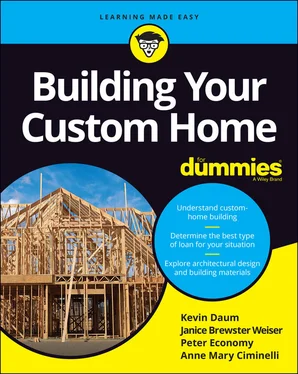1 ...7 8 9 11 12 13 ...20
Defining “dollars per square foot”
Many different people will use the term dollars per square foot throughout your home-building process. Interestingly enough, however, no one uses a specific widely accepted definition. A real-estate agent may state dollars per square foot as the sales price of the home divided by the square footage, including the land. A contractor may or may not include items such as permits or financing in their estimates of dollars per square foot. After you have bids, the term actually becomes meaningless, but during the early stages of your project, you need a common understanding of what it means.
To decipher your dollars-per-square-foot quotes, you have to define dollars and square foot the same way for each person you work with. Then you can make sure everyone is on the same page in every relevant conversation. The following sections outline one helpful approach to try.
Step 1: Define square footage
First, create a definition of square footage. Square footage, for this purpose, needs to include all living space enclosed by walls that is completely finished. Your definition of square footage needs to include the square footage of the following:
Bathrooms
Bedrooms and closets
Den
Dining room
Family room/great room
Fully finished basement
Guesthouse
Hallways and entryways
Home theater and/or game room
Kitchen, laundry room, and pantry
Add the square footage together, and this total serves as your definition of the total square footage. However, your definition of square footage doesn’t include square footage for the following:
Attached decks
Garage
Patios
Unfinished basement
Workshop buildings
Now that you have the total square footage, you need to define the dollars necessary in the budget to define dollars per square foot. You don’t want to include all the construction costs in this dollar amount; many costs need to be evaluated independently. Exclude the following costs from this part of the calculation:
Financing
Hardscaping (unattached decks, pools, fences, and so on)
Land
Landscaping
Soft costs (permits, plans, and fees)
So, what’s included in your definition of the dollars? Mostly labor and materials construction costs for all the living space we mention in the “ Step 1: Define square footage” section are included, plus a few other construction costs, such as the cost of the following:
Attached decks and patios
Driveways
The garage
Unfinished basement space
Walkways
Take all your cost estimates and add them together to create a total dollars number.
Step 3: Calculating dollars per square foot
Divide the total dollars from Step 2 by the square footage from Step 1 to establish your dollars per square foot. Easy, huh?
Alternatively, you can take your total construction budget, subtract the excluded items from Step 2, and divide by the square footage to determine how much you have available to spend per square foot.
For example, if you have a total budget of $350,000 available and your square footage is 2,500 square feet, your budget would be $140 per square foot. You can then tell a contractor that you can only spend $140 per square foot for construction of the house, not including land, soft costs, financing, hardscaping, and landscaping, but that price must include the garage, driveways, walkways, attached decks, and any unfinished space.
Using a budgeting template
To put all this information together, we suggest using the following template to make everything easier. You need to do your own research to fill in the spaces for your project, but the following is a sample preliminary budget for a typical custom-home project that you can scratch out on any napkin.
Funds available: Add your available cash and the loan amount for your total budget, like this:Cash$175,000Loan amount$650,000a. Total budget$825,000
Cost-to-build: Add all your costs together for your total cost.Land$200,000Soft costs (permits, plans, and fees)$40,000Hard costs ($160 × 2,650 square feet)$424,000Financing (interest and closing costs)$35,000Landscaping$40,000Hardscaping$25,000b. Total cost$764,000
 This template can give you a starting point for budgeting, but you do need to educate yourself on each of these line items to get a real picture of your project’s costs. (Check out the Table of Contents to see where we discuss each topic for more information.)
This template can give you a starting point for budgeting, but you do need to educate yourself on each of these line items to get a real picture of your project’s costs. (Check out the Table of Contents to see where we discuss each topic for more information.)
Most people building a custom home end up hiring a general contractor to do the job. In fact, 80 percent of custom-home projects have a general contractor involved in some capacity. Many people find great comfort in having someone with experience managing the job while they earn the money to pay for the project. If you’re considering being an owner-builder and not using a contractor, check out Chapter 1to see if you’re truly up to the task.
Every contractor has a standard contract and practices they use with their business. Remember that you have the right to negotiate and compromise on issues before entering into any contract. Of course, the contractor also has the right to decline the job.
There is no set time to engage your contractor as long as it’s a minimum of 60 days before you start construction so they have time to get everything ready for the build. Many people opt to engage a contractor much earlier in the process so that the contractor is actively involved during the design process.
After you and your contractor establish a contract and you’re on your way, the two of you need to work as a team to build your custom home. In this section, we look at the contractor selection process. (You can find more information on managing your contractor relationship in Chapter 7.)
Understanding the contractor’s role
In most cases, the contractor doesn’t handle the hammer-and-nails part of your custom-home project. Although some contractors may participate in parts of the actual construction, their primary job is to manage the workflow and project materials and make sure everything is happening in a timely and workmanlike manner. Here are the contractor’s major responsibilities:
Obtaining the final permits
Managing the production schedule
Sourcing and buying the materials
Hiring and managing the subcontractors (or subs )
Keeping the site safe and clean
Managing the inspections
Managing the budget
Keeping you informed
Performing quality control
Solving any problems that arise
 Not every contractor will handle all these items. When you hire your contractor, ask them how much you’ll handle directly and what the contractor will handle. If possible, the contractor’s specific scope of work should be spelled out in your contract with them. Good communication is the key to making sure you don’t waste any time or effort doubling up on tasks.
Not every contractor will handle all these items. When you hire your contractor, ask them how much you’ll handle directly and what the contractor will handle. If possible, the contractor’s specific scope of work should be spelled out in your contract with them. Good communication is the key to making sure you don’t waste any time or effort doubling up on tasks.
Getting bids: Comparing apples to apples
If you didn’t start the custom-home process with a contractor in mind, you’ll probably give your plans and specifications (or specs ) to a few different contractors to get an estimate. This process is called putting your plans out to bid.
Читать дальше

 This template can give you a starting point for budgeting, but you do need to educate yourself on each of these line items to get a real picture of your project’s costs. (Check out the Table of Contents to see where we discuss each topic for more information.)
This template can give you a starting point for budgeting, but you do need to educate yourself on each of these line items to get a real picture of your project’s costs. (Check out the Table of Contents to see where we discuss each topic for more information.)










